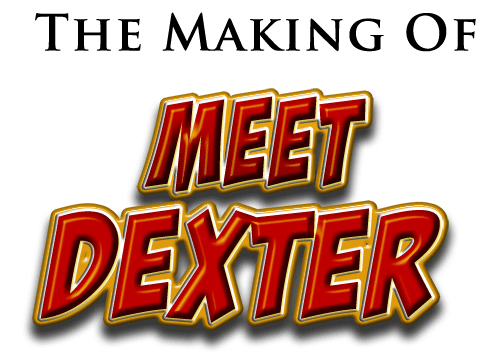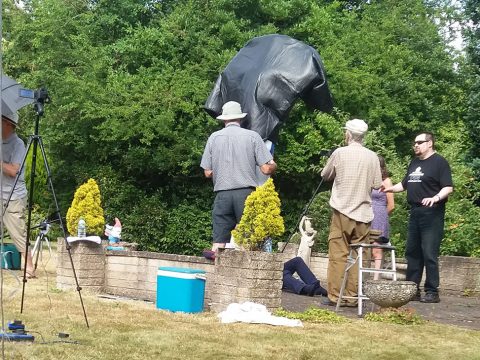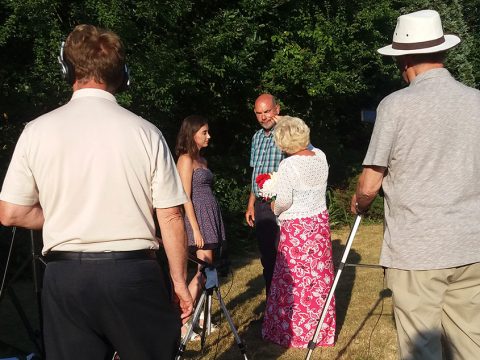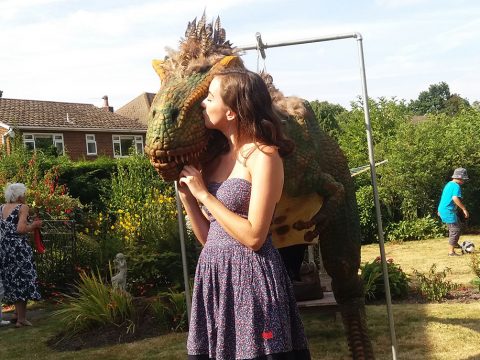
OR
“NEVER WORK WITH CHILDREN, ANIMALS OR DINOSAURS!”
Part Three:
Editing And Lessons Learned
Typically films aren’t shot in chronological order and this was no different although we did start close to the running order for the early scenes, seeing as Dexter wasn’t due to arrive until a little later. In hindsight one shot we should have done much earlier was where Dexter’s shadow looms over the parents – the reason being that by the time we came to film it, the sun had selfishly moved thus we couldn’t get the shadow to appear in the same spot the actors where previously situated in the surrounding in scenes.
When it came to the edit the sun’s movement as the day progressed also caused a problems with the colour grading in the later scenes, and the use of reflectors on set to counter this problem didn’t help either. Bearing in mind though the shoot ran for over six hours and was still very light by the time wrapped we did well to get the amount of natural sunlight we did and in the final analysis, it is only a few shots that are affected by this.

For a couple of shots I was ambitious and used the club dolly, as I wanted the opening scene to be a single take, all movement parade of people to lead into the first scene with dialogue. We actually did this in only a few takes and John did a good in keeping the camera moving; the only minor niggle, which I didn’t spot until the edit, was that at the end of the shot we could see Andy’s gazebo, the rest of the crew all standing around in the background and the back of Olive’s house when this was meant to be a public park!
Similarly, while another dolly shot was being filmed by John and Andy, David (Laker’s) camera was filming Sue’s reaction shot at the same time – in the edit we could clearly see John and Andy in the background behind Sue with the dolly filming David and Hannah! But, as Professor Mike Shaw likes to say, this was “fixed in post”.
Editing is that strange beast in that it is rewarding and often fun but tiresome and just as likely to cause stress as the shoot itself. The first few stages are always a joy, seeing two different frames attached to one another for the first time but as the job progresses this tends to lose its lustre (perhaps I should nail it down in future), unless one pulls off a smooth cut where movement is involved maintaining the natural flow and tempo between shots.
I can’t speak for other people as I don’t do impersonations, but when I edit I tend to find the first day sees plenty of work done then the next I’m redoing what I did the day before. Perhaps this is me being a perfectionist or maybe we see things much more clearly after a break, or when I have my glasses on which also helps. This meant the edit was one of the longer ones I have undertaken through forever fixing what I had already done.
Yet I learned so much during this process, not in the least because I was using my upgraded editing software for the first time so I was learning on the job. Despite knowing what keyframes were, I had never used them before but they came in handy for a number of shots, as did many of the built in effects my software boasts, which I was previously too scared to use.

Also during the edit, I was inspired to add new ideas to the presentation and narrative beyond what I already had dancing about in my head and in the script. The arrival of Dexter, for instance, was more abrupt and less visually evident that this huge beast was arriving imminently. I realised I needed some kind of transition between the two shots of the parents but couldn’t figure out what.
Then I noticed when Hannah says “Meet Dexter” the bushes behind David and Sue are ruffled by a gentle breeze, reminding me of old cartoons when the ground would shake when a large monster would appear. So I located footage of the garden and applied an earthquake effect to it, along with a candid outtake of Penny (whom I was pained about cutting from the film), and voila! we have a credible transition scene to denote Dexter’s arrival I would never have thought of before!
But each filming experience is a huge learning curve and I for one can say unequivocally that has been the most educational filming experience of my meagre 6-year filmmaking career thus far, not limited to the instances outline above, and I hope that everyone else involved also took something from working on this shoot.
That said, the most important thing I learned from it was why I rarely make films!
Once again, an almighty humongous and heartfelt thanks to everyone who was involved in making MEET DEXTER and thanks for reading!

Missed Part One? Read it HERE
Missed Part Two? Read it HERE
Words: Lee Relph
Photos: Kuldip Kuar